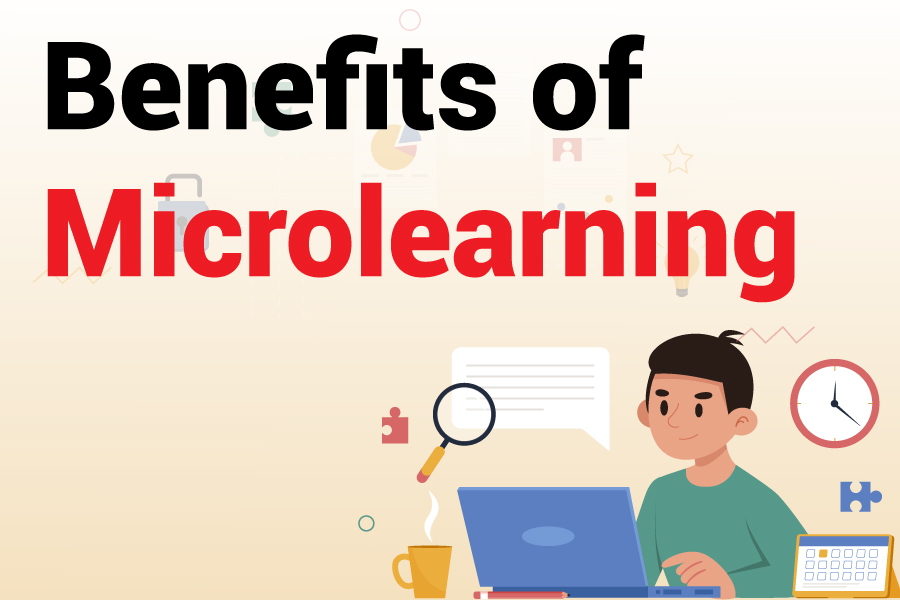In the rapidly evolving landscape of modern learning, the concept of micro-learning has emerged as a game-changer. Micro-learning, as the name suggests, involves breaking down complex information into bite-sized, easily digestible chunks. These concise learning modules are designed to deliver targeted knowledge in a focused and efficient manner, catering to the needs of learners in the digital age.
Micro-learning is a departure from traditional, monolithic training programs that often overwhelm learners with an abundance of information. Instead, it embraces the principles of modularity, flexibility, and accessibility, allowing learners to consume knowledge at their own pace and convenience.
The Importance Of Micro-Learning In Today’s Fast-Paced World
In our fast-paced, information-saturated world, attention spans are shrinking, and the demand for immediate gratification is on the rise. Micro-learning aligns perfectly with these evolving trends by offering learners the ability to acquire knowledge in short bursts, making it easier to retain and apply the acquired information.
Moreover, the proliferation of mobile devices and the ubiquity of internet access have created an environment where learners expect on-demand access to knowledge. Micro-learning capitalizes on this reality by providing bite-sized learning experiences that can be consumed anytime, anywhere, making it an ideal solution for the modern learner.
Benefits Of Micro-Learning For Learners
Improved Retention: By breaking down complex concepts into manageable chunks, micro-learning enhances knowledge retention. Learners can focus on one concept at a time, reducing cognitive overload and increasing the likelihood of retaining the information.
Personalized Learning: Micro-learning empowers learners to tailor their learning experience to their individual needs and preferences. They can choose the specific topics or skills they want to focus on, allowing for a more personalized and relevant learning journey.
Flexibility and Convenience: With micro-learning, learners can access learning materials at their convenience, whether during breaks, commutes, or any spare moment. This flexibility accommodates diverse schedules and learning styles, making it easier to integrate learning into daily routines.
Improved Engagement: The bite-sized nature of micro-learning modules helps maintain learner engagement and motivation. Short, focused sessions prevent boredom and fatigue, keeping learners actively involved in the learning process.
Benefits Of Micro-Learning For Organizations
- Increased Productivity: By providing employees with targeted, just-in-time training, micro-learning minimizes disruptions to workflow and maximizes productivity. Employees can quickly acquire the necessary knowledge or skills without extended periods away from their primary responsibilities.
- Cost-Effectiveness: Developing and delivering micro-learning modules is generally more cost effective than traditional training programs. Organizations can create and update content more efficiently, reducing expenses associated with instructor-led training and travel costs.
- Agility and Responsiveness: In today’s rapidly changing business environment, organizations need to adapt quickly to new trends, technologies, and market demands. Micro-learning enables organizations to rapidly develop and deploy targeted training modules, ensuring employees stay up-to-date with the latest knowledge and skills.
- Talent Development and Retention: By offering engaging and flexible learning opportunities, organizations can foster a culture of continuous learning and professional development. This not only enhances employee skills but also contributes to talent retention and job satisfaction.
How Micro-Learning Enhances Knowledge Retention
Micro-learning is designed to optimize knowledge retention by leveraging several cognitive principles and learning theories. One of the key factors contributing to improved retention is the concept of spaced repetition. By presenting information in small, spaced intervals, micro-learning reinforces the learned material, allowing it to be better consolidated in long-term memory.
Additionally, micro-learning aligns with the principles of cognitive load theory, which suggests that learners have limited working memory capacity. By breaking down complex concepts into manageable chunks, micro-learning reduces cognitive overload, making it easier for learners to process and retain the information.
Furthermore, micro-learning capitalizes on the principles of multimedia learning, which suggest that combining different modalities, such as text, visuals, and audio, can enhance understanding and recall. Micro-learning modules often incorporate various multimedia elements, creating a multisensory learning experience that reinforces knowledge retention.
Micro-Learning As A Cost-Effective Training Solution
One of the significant advantages of micro-learning is its cost-effectiveness compared to traditional training methods. By leveraging technology and digital platforms, organizations can develop and deliver micro-learning modules at a fraction of the cost associated with instructor-led training or classroom-based programs.
- Reduced Development Costs: Creating micro-learning modules is generally less resource-intensive than developing comprehensive training programs. The modular nature of micro-learning allows for the reuse and repurposing of existing content, reducing duplication of effort and minimizing development costs.
- Scalability and Accessibility: Micro-learning modules can be easily distributed and accessed through various digital channels, such as learning management systems (LMS), mobile apps, or online platforms. This eliminates the need for physical infrastructure, travel expenses, and logistical costs associated with traditional training methods.
- Efficient Updates and Maintenance: As micro-learning modules are focused on specific topics or skills, updating or modifying content is more straightforward and cost-effective. Organizations can quickly adapt and enhance their training materials to reflect changes in industry best practices, regulations, or organizational policies.
- Reduced Opportunity Costs: By delivering training in bite-sized chunks, micro-learning minimizes disruptions to employee productivity. Employees can access micro-learning modules during downtime or brief breaks, reducing the opportunity costs associated with extended training sessions or off-site programs.
Ways To Implement Micro-Learning In Your Organization
Implementing micro-learning in your organization can be a transformative step toward enhancing employee learning and development. Here are some effective ways to incorporate micro-learning into your training strategy:
Leverage Existing Content: Start by identifying and repurposing existing training materials, such as instructional videos, presentations, or manuals, into micro-learning modules. Break down these resources into concise, focused topics that can be consumed in short bursts.
Utilize Mobile Platforms: Develop micro-learning modules that are optimized for mobile devices, allowing learners to access content on the go. Mobile apps, responsive websites, or learning management systems with mobile compatibility can facilitate seamless access to micro-learning resources.
Encourage User-Generated Content: Empower subject matter experts and experienced employees to create micro-learning modules based on their expertise. This not only leverages internal knowledge but also fosters a culture of knowledge-sharing and collaboration.
Integrate Micro-Learning into Workflows: Identify opportunities to embed micro-learning modules directly into existing workflows or software applications. This just-in-time learning approach ensures that employees have access to relevant knowledge when they need it most.
Gamify the Learning Experience: Incorporate gamification elements, such as badges, leaderboards, or rewards, into your micro-learning platform. This can enhance engagement, motivation, and healthy competition among learners, making the learning experience more enjoyable and effective.
Best Practices For Designing Micro-Learning Modules
To maximize the effectiveness of micro-learning, it’s essential to follow best practices in the design and development of micro-learning modules. Here are some key considerations:
- Focus on Specific Learning Objectives: Each micro-learning module should have a clear and concise learning objective, addressing a specific skill, concept, or task. This focused approach ensures that learners can easily grasp and apply the acquired knowledge.
- Embrace Multimedia and Interactivity: Incorporate various multimedia elements, such as videos, animations, infographics, and interactive quizzes, to enhance engagement and cater to different learning styles. Interactivity can also reinforce knowledge retention and application.
- Optimize for Mobile Devices: Design micro-learning modules with responsive layouts and mobile-friendly formats, ensuring seamless access and usability across various devices and screen sizes.
- Chunk and Sequence Content Effectively: Break down content into logical, bite-sized chunks and sequence them in a way that facilitates progressive learning. This helps learners build upon previous knowledge and reinforces connections between related concepts.
- Encourage Self-Paced Learning: Allow learners to control the pace and sequence of their learning by providing easy navigation and access to micro-learning modules. This self-paced approach caters to diverse learning styles and preferences.
- Incorporate Assessments and Feedback: Include short quizzes, knowledge checks, or interactive exercises within micro-learning modules to reinforce learning and provide immediate feedback. This helps learners gauge their understanding and identify areas for improvement.
- Promote Social Learning and Collaboration: Encourage learners to share their experiences, insights, and feedback on micro-learning modules through discussion forums, social media, or collaborative platforms. This fosters a sense of community and facilitates peer-to-peer learning.
Examples Of Successful Micro-Learning Programs
Organizations across various industries have embraced micro-learning, demonstrating its versatility and effectiveness. Here are a few examples of successful micro-learning programs:
Deloitte’s Leadership Development Program
Deloitte, a leading professional services firm, implemented a micro-learning program to support leadership development. The program consists of bite-sized modules covering topics such as communication, decision-making, and team management. Employees can access these modules on demand, enabling continuous learning and skill development.
Walmart’s Retail Training Initiative
Walmart, a global retail giant, leveraged micro-learning to train its vast workforce on customer service, product knowledge, and operational procedures. The company developed short, interactive modules that employees could access on mobile devices, ensuring consistent and efficient training across multiple locations.
McDonald’s Crew Training
McDonald’s, a global fast-food chain, adopted micro-learning to train its crew members on various aspects of restaurant operations, food preparation, and customer service. The bite-sized modules allowed for just-in-time training, reducing downtime and enhancing employee productivity.
Salesforce’s Trailhead Learning Platform
Salesforce, a leading cloud-based software company, created Trailhead, a gamified micro-learning platform. Trailhead offers a wide range of micro-learning modules focused on Salesforce products, coding, and business skills. Users can earn badges and points as they progress through the modules, fostering engagement and continuous learning.
Conclusion
In the rapidly evolving landscape of modern learning, micro-learning has emerged as a powerful and transformative approach. By breaking down complex information into bite-sized, easily digestible chunks, micro-learning addresses the challenges of limited attention spans and the need for immediate gratification.
The benefits of micro-learning are numerous, ranging from improved knowledge retention and personalized learning experiences for learners to increased productivity, cost-effectiveness, and agility for organizations. Micro-learning aligns perfectly with the principles of cognitive load theory, spaced repetition, and multimedia learning, enhancing the effectiveness of knowledge acquisition and retention.
As we navigate the ever-changing demands of the digital age, embracing micro-learning becomes a strategic imperative for organizations seeking to foster a culture of continuous learning and professional development. By implementing micro-learning initiatives and following best practices in module design, organizations can empower their workforce with just-in-time knowledge, enabling them to adapt swiftly to new challenges and opportunities.












































Leave a Reply